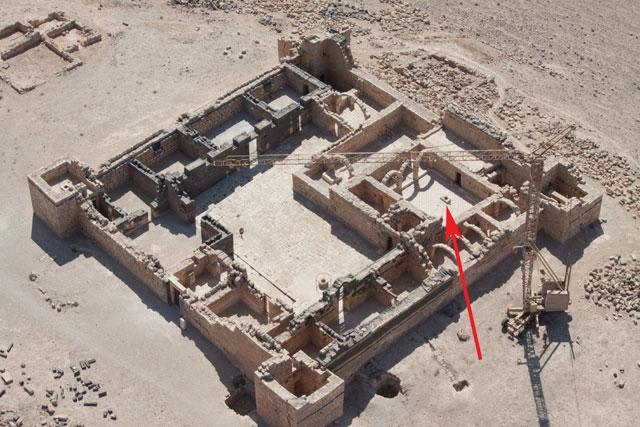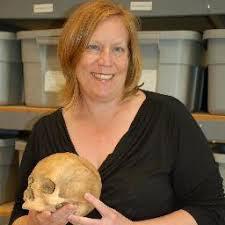You are here
Forensic research seeks to solve mysterious deaths at Qasr Hallabat archaeological site
By Saeb Rawashdeh - Jun 08,2018 - Last updated at Jun 08,2018

The arrow points to the cistern at the archaeological site of Qasr Hallabat where the researchers revealed remains of five suspected victims of homicide (Photo courtesy of Megan Perry)
AMMAN — Forensic anthropology usually involves the investigation of recent, medico-legally significant human remains as opposed to ancient skeletons recovered from archaeological sites, an American researcher explained.
These two perspectives recently merged at the archaeological site of Qasr Hallabat (35km northeast of Amman), where the skeletons of five people showing signs of homicide were found in one of the site’s cisterns, pushing bio-archaeologists to formulate stories surrounding their death.
“To establish the antiquity of these remains, we first relied on the stratigraphy text from excavations by Ignacio Arce [former director of the Spanish Archaeological Mission] and his team to determine that these were not modern individuals, and probably dated shortly after Qasr Hallabat went out of use,” said anthropology professor at East Carolina University Megan Perry.
To better establish the date of the skeletons, we submitted bone samples from two of the individuals for carbon-14 dating of the skeletons. The dating process estimates when these individuals died and when the decay of 14C isotopes in their body began, the scholar explained.
“This not only confirmed Arce’s relative date provided by the stratigraphy, but also established an absolute range of 768-895 AD for their deaths, and presumably the dates when they were deposited into the cistern,” she elaborated.
The skeletal analysis, however, gave some clues about the circumstance of the individuals’ death, noted Perry, who also serves as a consultant on forensic anthropology cases in the US.
“Analysis of the skeletons by me and one of my graduate students Taylor Montgomery, identified several injuries in the bones that occurred perimortem [at or near the time of death]. Trauma that occurs before death shows some skeletal response at the point of injury, which can be seen by the naked eye or by a thin section of the bone,” the scholar highlighted, adding that damage to the body or bones that happens after death can be identified as having different colour or texture of the trauma edges than the rest of the bone and a more flaked, splintered breakage pattern.
The areas of injury in the Hallabat skeletons did not show any bone healing nor did they have the same characteristics of postmortem (after death) damage, Perry pointed out.
In addition, five of the skulls had evidence of blunt force trauma, and some of the arms and legs had signs of sharp force trauma. Furthermore, the patterning and timing suggested that it was homicide rather than accidental trauma or suicide, she underlined.
“We were also interested to note that a few of the skulls had healed cranial blunt force trauma that had occurred some years before death. Thus, some of these folks had been in violent skirmishes before,” stressed Perry, who conducted isotope analysis of the dental enamel of these individuals alongside graduate student Kathryn Parker “to identify their geographic origin”.
“The dental enamel absorbs various isotopes from the food and water [or breast milk] a child consumes while the teeth are forming, which, based on the teeth that we used, would be about birth to four years of age,” Perry noted, adding that the ratios of some isotopes, such as strontium and oxygen, vary across the landscape [strontium based on bedrock geology, oxygen based on water sources].”
“So, by comparing the isotope ratios of strontium and oxygen in the dental enamel to those expected at Hallabat, we can identify if these individuals grew up around Hallabat during childhood,” she explained, noting that the ratios show that the individuals most likely spent their childhood moving between the basalt fields of the Hauran, to the north and east of Hallabat, and the limestone regions of Hallabat.
“Considering that they originated in the same region and died at the same place presumably at the same time, they have a shared life history,” the professor claimed, saying that the best hypothesis is that they were part of a group of pastoral nomads or traders that moved regularly across the landscape as children.
“Perhaps they were still mobile and making temporary use of the water sources of Hallabat when some of them were killed,” the researcher elaborated.
“Who disposed of them in the cistern remains an open question, but, considering that the cisterns of Hallabat provided important water sources for the area, it does not seem logical that a group making regular use of them would contaminate one with dead bodies. So perhaps they were outsiders, or a local group who wanted to deter others from using the Hallabat resources. It remains a mystery,” Perry concluded.
Related Articles
AMMAN — The emergence of bioarchaeology has enabled archaeologists and anthropologists to use more scientific methods to analyse the lives o
AMMAN — A relatively new approach in the discipline, the archaeology of architecture was at the heart of a recent lecture held as part of th
AMMAN — Amman is the only Arab city that can brag about having a complete town from Islamic times with all of its components, according to I

















